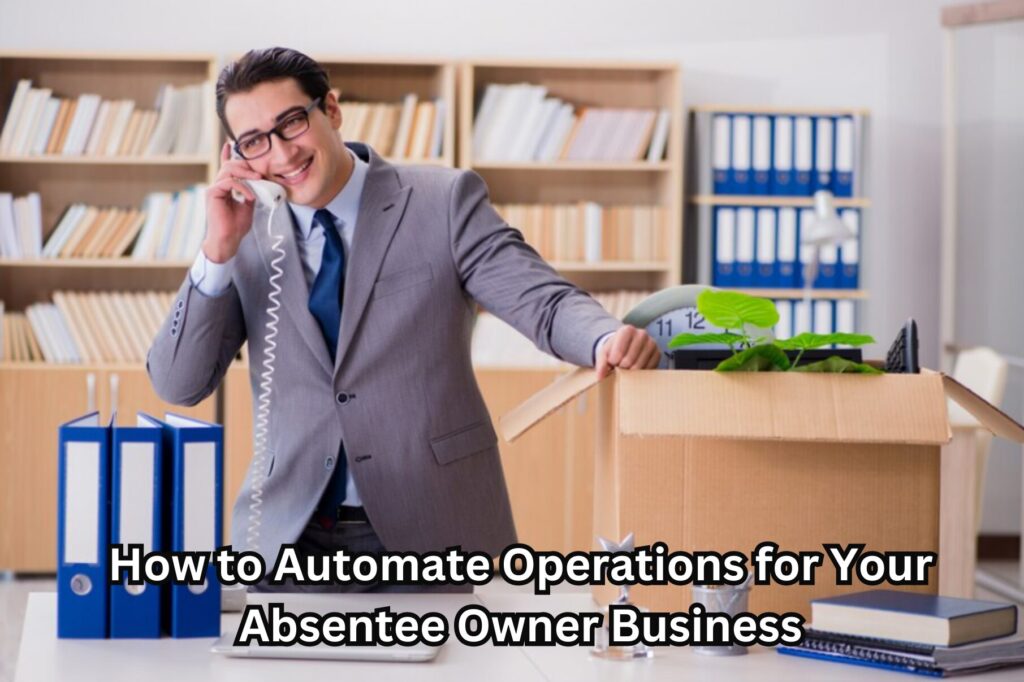Are you an absentee owner struggling to manage your business efficiently? Operating a business poses unique challenges. But with the right strategies, you can streamline operations. You can achieve success without being there. This comprehensive guide will share effective methods to automate tasks and optimize processes. We’ll also discuss ways to enhance the productivity of your absentee owner’s business.

Understanding the Absentee Owner Business Model
What is an Absentee Owner Business?
Running a business as an absentee owner entails owning and overseeing a venture. It involves no day-to-day operational involvement. This approach allows owners to pursue other ventures, travel, or focus on personal matters. They can maintain ownership and decision-making authority.
Challenges Faced by Absentee Owners
Being physically distant from your business presents several challenges. For example, there are communication barriers. There is monitoring of employee performance. There is ensuring seamless operations without direct supervision.
The Benefits of Automation for Absentee Owner Businesses
Efficiency Enhancement through Automation
Implementing automation tools and software can significantly improve efficiency. They reduce manual labor, cut errors, and speed up repetitive tasks.
Cost Savings and Resource Optimization
Automating operations leads to cost savings. It streamlines processes, reduces labor expenses, and optimizes resource use. This contributes to increased profitability.
Identifying Areas for Automation
Task Prioritization and Delegation
Use task management tools to rank activities and delegate responsibilities. Make sure you complete critical tasks efficiently in your absence.
Implementing Technology for Remote Monitoring
Use cameras, sensors, and remote monitoring software to oversee operations. Ensure compliance and maintain security protocols.
Automating Administrative Processes
Use software solutions for payroll, invoicing, inventory management, and CRM systems. This will streamline administrative tasks and improve accuracy.

Choosing the Right Automation Tools and Software
Assessing Business Needs
Test your business requirements. Select automation tools that align with your goals. Consider factors like scalability, ease of use, and integration capabilities.
Popular Automation Tools for Absentee Owner Businesses
Explore various tools like project management software and customer relationship management (CRM) systems. Also, look into accounting software and communication platforms tailored to remote management.
Implementing Automation Strategies
Employee Training and Adaptation
Ensure thorough training and support for your team when implementing new automation tools. This will ease a smooth transition and maximize their effectiveness.
Continuous Evaluation and Improvement
Regularly assess the performance of automation tools. Gather feedback and make necessary adjustments to optimize efficiency. Address any operational gaps.
Overcoming Challenges and Maximizing Success
Building a Reliable Remote Team
Invest in hiring and nurturing a competent remote team. This ensures smooth operations. It also ensures effective communication and a shared commitment to the business’s success.
Establishing Clear Communication Channels
Use communication tools and regular meetings. Maintain transparent and open communication channels with your remote team and stakeholders.

Absentee Owner Business FAQs
Q: What is the best business for absentee owners?
The best business for an absentee owner allows for efficient management and operation. It does not need constant physical presence. Service-based companies, such as laundromats, car washes, and vending machines, are often suitable. Online companies, like e-commerce stores, dropshipping, and affiliate marketing, also fit this category. These ventures typically rely on automated processes, robust systems, and competent staff. Owners can oversee operations remotely.
Q: What is an example of an absentee business?
An example of an absentee business is a self-service laundromat. Once the equipment and systems are set up, a laundromat operates independently. Customers use the machines. They pay for the service without needing the owner’s direct oversight. An absentee owner can manage the business from a distance. This requires proper maintenance and occasional checks. They don’t need to be on-site regularly.
Q: What is an example of an absentee owner?
An example of an absentee owner could be someone who owns multiple rental properties. They do not handle day-to-day property management tasks. Instead, they hire property managers or use property management software. These handle tenant interactions, maintenance requests, rent collection, and other administrative duties. The owner’s involvement might be occasional or limited to high-level decision-making. This allows them to focus on other endeavors while the properties generate income.
Q: What is an absentee owner of a franchise?
An absentee owner of a franchise is an individual who owns a franchise business. However, they are not actively involved in its daily operations. For instance, someone owning a fast-food franchise may hire a competent manager and staff. They handle the restaurant’s day-to-day functioning. The absentee owner might periodically check the business’s financial aspects and strategic decisions. They might also oversee the business. They rely on the appointed management team to handle the operational tasks.
Conclusion
Automating operations is a game-changer for absentee owner businesses. It empowers owners to manage their ventures efficiently from a distance. Strategically implement automation tools. Identify areas for optimization. Foster a reliable remote team. This will help you overcome challenges and thrive in the competitive business landscape. You can do this even if you are physically absent.
Boost Your Productivity!
Join our weekly newsletter for top time management tips and productivity strategies. Subscribe now for the latest insights and a special bonus guide: How to Automate Operations for Your Absentee Owner Business.





